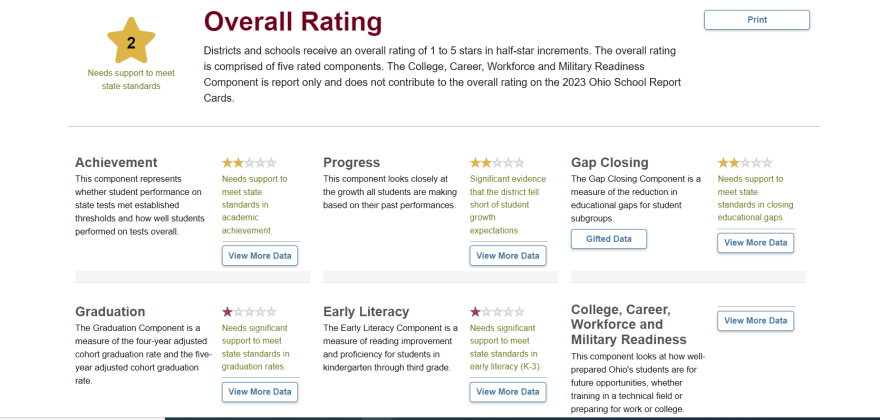The state has released its annual report card scores of school districts across Ohio, and it again shows relatively low scores for the school districts serving low-income students throughout the state.
In Northeast Ohio, that includes the major urban school districts in Cleveland, Akron, Youngstown and Canton.
In the 2022-23 academic year, Canton City School District showed improvement in a number of categories compared to the 2021-22 year. In the areas of "achievement," which measures students' state test scores, and "progress," which measures students based on past performance, the district improved from one star on last year's report card to two stars this year. But still, Canton's overall scores - one star in "early literacy," one in "graduation" and two in "gap closing" - fall short of meeting state standards (three out of five stars).

Canton Board of Education member Eric Resnick has long been a critic of the way the state measures performance through the annual report card. He said there's almost a "perfect correspondence" between poverty and low state report card scores.
"If you look at the top five percent and the bottom five percent in the state as a whole, the bottom five percent are the high-poverty school districts and the top five percent are the very affluent school districts," Resnick said.
You can find your school district's report card results on the Ohio Department of Education's website.
The state this year has returned to the practice of giving an overall score to school districts, which can now be broken down into increments of half a star. A summary of the scores for Northeast Ohio's major urban school districts are as follows:
* Cleveland Metropolitan School District, 2.5 stars overall. Compared to last year's report card, CMSD scored a little worse, three out of five stars, on gap-closing, meant to measure how well schools are closing achievement gaps based on students' race or disability status. It still scored highly on the "progress" measure, same as it did last year, four out of five stars.
* Akron Public Schools, 2.5 stars overall. Akron's gap-closing score dropped from three stars to two stars this year, while its graduation-rate measure improved from one star to two.
* Youngstown City School District, 2.5 stars overall. Youngstown's gap-closing score increased from three to four stars this year. It scored two stars on the progress measurement, same as it did last year.
* Canton City School District, two stars overall. Canton schools received two stars in every category outside of graduation and early literacy, where it received one star.
All of the schools above scored either one or two stars out of five in the areas of early literacy and graduation rates, which have long been areas they and other major urban school districts have struggled with. Many of them have implemented free preschool programs in recent years to try to address students' problems with reading on grade-level.
Comparatively, schools in the wealthiest areas of Northeast Ohio continue to post high scores. Rocky River, Orange, Hudson and Solon public schools all received five out of five stars overall this year.
East Cleveland City School District, which is under the auspices of an academic distress commission, showed incremental improvement this year, with scores in the areas of progress and early literacy jumping to two stars out of five compared to one star last year. Ideastream Public Media has recently reported on those signs of progress there.
Meanwhile, Lorain City School District, which received a carve-out in the state budget to remove its academic distress commission this year, received lower scores than it did last year. Its gap-closing score dropped to two stars from four, and its progress score dropped from four to two stars.
Canton's Resnick said some school districts like Toledo have begun issuing their own "local" report cards that better measure the hard work they're doing to turn students' lives and academics around.
"They talk about equity measurements and things that their students are really accomplishing, which look very different from what the state report card measures and that the state report card does not take into account," he said. "(There are) a lot of the things that students get, either in the social emotional realm or with regard to gap closing and equity that is very relevant to their success as adults going forward."
School districts' achievement scores are improving overall since the pandemic, as are students' early literacy scores, the Ohio Department of Education said. Chronic absenteeism has dropped overall from 30.2% to 26.8% (defined as students missing 10% or more of school hours), but remains a "concern," the department said in a news release about the report cards.
The Thomas B. Fordham Institute, a Columbus-based education policy nonprofit, said in a news release, the report cards paint a "mixed picture" of post-pandemic academic recovery.
"Ohio students on average have generally recovered in reading, but progress remains sluggish in mathematics with students still significantly behind pre-pandemic levels," the institute said. "Meanwhile, chronic absenteeism data indicate that too many students are missing large amounts of class time."
The chronic absenteeism rates analyzed by the Fordham Institute show Cleveland and Akron's chronic absenteeism rates have skyrocketed since the pandemic, from about 30% prior to the pandemic to 56% in the last school year.



